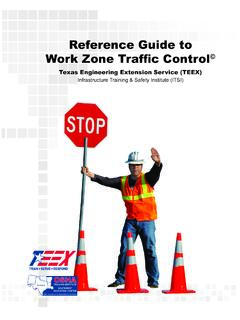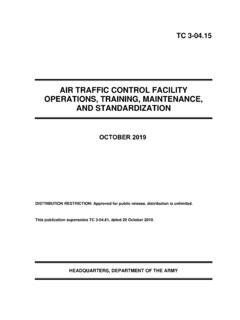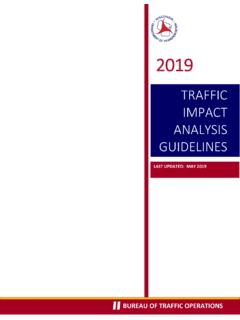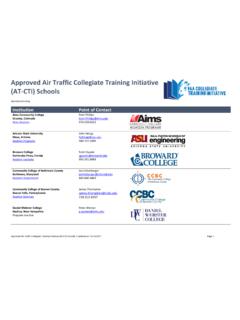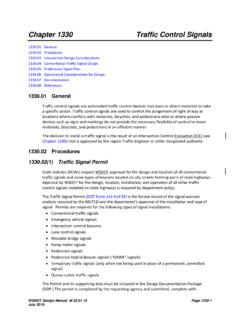Transcription of Air Traffic Control, Airfield/Heliport, and Airspace ...
1 army Regulation 95 2 AviationAir Traffic control , Airfield/Heliport, and AirspaceOperationsHeadquartersDepartment of the ArmyWashington, DC31 March 2016 UNCLASSIFIEDSUMMARY of CHANGEAR 95 2 Air Traffic control , Airfield/Heliport, and Airspace OperationsThis major revision, dated 31 March 2016--o Changes the title from Airspace , Airfields/Heliports, Flight Activities, AirTraffic control , Navigational Aids to Air Traffic control , Airfield/Heliport, and Airspace Operations (cover).o Updates Secretary of the army responsibilities (para 1-8).o Clarifies policy for air Traffic control facility types (para 2-3).o Updates radio frequency allocation requirements (para 2-12).o Clarifies policy for unmanned aircraft system Airspace integration into theNational Airspace System (implements army Directive 2012-02)(para 7-6).o Revises policy for air Traffic control equipment maintenance (chap 8).o Clarifies policy for quality assurance evaluation programs (para 10-7).
2 O Revises frequency requirements for assistance and compliance evaluations(para 10-7e).o Updates procedures for establishing, maintaining, and validating flightinformation publication accounts (paras 13-10 through 13-16).o Adds post construction airfield/heliport certification and safetyverification example checklist (app E).o Revises policy for air Traffic control operations (throughout).HeadquartersDepartment of the ArmyWashington, DC31 March 2016 AviationAir Traffic control , Airfield/Heliport, and Airspace Operations* army Regulation 95 2 Effective 30 April 2016H i s t o r y . T h i s p u b l i c a t i o n i s a m a j o This regulation provides ad-m i n i s t r a t i v e a n d o p e r a t i o n a l p o l i c y a n dp r o c e d u r e s f o r a l l A r m y o r g a n i z a t i o n sproviding air Traffic control , airfield/heli-port, and Airspace operations This regulation applies tot h e A c t i v e A r m y , t h e A r m y N a t i o n a lGuard/ army National Guard of the UnitedStates, and the army Reserve, unlessotherwise stated.
3 It also applies to all per-sonnel who perform duties in army airt r a f f i c c o n t r o l f a c i l i t i e s a n d s u p p o r and exception proponent of this regulation is theDeputy Chief of Staff, G 3/5/7. The pro-ponent has the authority to approve ex-ceptions or waivers to this regulation thata r e c o n s i s t e n t w i t h c o n t r o l l i n g l a w a n dregulations. The proponent may delegatethis approval authority, in writing, to ad i v i s i o n c h i e f w i t h i n t h e p r o p o n e n tagency or its direct reporting unit or fieldoperating agency, in the grade of colonelor the civilian equivalent. Activities mayrequest a waiver to this regulation by pro-v i d i n g j u s t i f i c a t i o n t h a t i n c l u d e s a f u l lanalysis of the expected benefits and mustinclude formal review by the activities senior legal officer.
4 All waiver requestswill be endorsed by the unit commanderor senior leader of the requesting activityand forwarded through their higher head-quarters to the policy proponent. Refer toAR 25 30 for specific internal control process. Thisregulation contains internal control provi-sions in accordance with AR 11 2 andidentifies key internal controls that mustbe evaluated (see appendix H).S u p p l e m e n t a t i o n . S u p p l e m e n t a t i o n o fthis regulation and establishment of com-mand and local forms are prohibited with-out prior approval of the Deputy Chief ofS t a f f , G 3 / 5 / 7 ( D A M O A V A ) , 4 0 0A r m y P e n t a g o n , W a s h i n g t o n , D C20310 improvements. Users areinvited to send comments and suggestedimprovements on DA Form 2028 (Recom-m e n d e d C h a n g e s t o P u b l i c a t i o n s a n dB l a n k F o r m s ) d i r e c t l y t o H e a d q u a r t e r s ,D e p a r t m e n t o f t h e A r m y( D A M O A V A ) , 4 0 0 A r m y P e n t a g o n ,Washington, DC 20310 This publication is availa-ble in electronic media only and is in-tended for command levels A, B, C, D,and E for the Active army , the ArmyNational Guard/ army National Guard oft h e U n i t e d S t a t e s , a n d t h e U.
5 S . A r m (Listed by paragraph and page number)Chapter 1 Introduction, page 1 Section IGeneral, page 1 Purpose 1 1, page 1 References 1 2, page 1 Explanation of abbreviation and terms 1 3, page 1 Responsibilities 1 4, page 1 Waivers and delegation of authority 1 5, page 1 Application in combat operations 1 6, page 1 Federal Aviation Administration and host nation coordination 1 7, page 1*This regulation supersedes AR 95 2, dated 10 April 95 2 31 March 2016iUNCLASSIFIEDC ontents ContinuedSection IIResponsibilities, page 1 Secretary of the army 1 8, page 1 Assistant Secretary of the army (Acquisition, Logistics and Technology) 1 9, page 2 Assistant Secretary of the army (Installations, Energy and Environment) 1 10, page 2 Assistant Secretary of the army (Manpower and Reserve Affairs) 1 11, page 2 Deputy Chief of Staff, G 2 1 12, page 2 Deputy Chief of Staff, G 3/5/7 1 13, page 3 Chief Information Officer/G 6 1 14, page 3 Assistant Chief of Staff for Installation Management 1 15, page 3 Chief of Engineers 1 16, page 3 Commanding General, army Corps of Engineers 1 17, page 3 army commands, army service component commands, direct reporting units, and army National Guard 1 18,page 3 Commanding General, army Materiel Command 1 19, page 4 Commanding General, army training and Doctrine Command 1 20, page 4 Commanding General/Chief, Aviation Branch, army Aviation Center of Excellence 1 21, page 4 Commander, army Aeronautical Services Agency 1 22, page 4 Commander, Air Traffic Services Command 1 23, page 5 Installation/garrison commanders 1 24.
6 Page 6 State Adjutant Generals 1 25, page 7 Additional responsibilities 1 26, page 7 Chapter 2 Air Traffic control Facilities and Services, page 7 Section army Air Traffic control , page 8 Mission 2 1, page 8 Air Traffic control authority 2 2, page 8 Air Traffic control facilities 2 3, page 8 Section IIEstablishing, retaining, and decommissioning air Traffic control facilities and navigational aids, page 8 Policy 2 4, page 8 Facilities development 2 5, page 9 Justifying or retaining air Traffic control facilities 2 6, page 10 Justifying or retaining navigational facilities and equipment 2 7, page 10 Establishment of army air Traffic control service 2 8, page 10 Establishment of an army approach control 2 9, page 10 Facilities requests 2 10, page 11 Navigational aids 2 11, page 12 Radio frequency allocations 2 12, page 12 Chapter 3 Air Traffic control Facility Operations, Evaluations, and Standardization, page 13 Operational agreement 3 1, page 13 Standard installation air Traffic control facility shift and work week 3 2, page 13 Tactical air Traffic control facility shift and work week 3 3, page 13 Inspections 3 4, page 14 Standardization 3 5, page 14 Safety 3 6, page 14 Flight inspection requirements 3 7, page 14 Safe aviation via exceptional service awards 3 8, page 14iiAR 95 2 31 March 2016 Contents ContinuedContracting air Traffic control services 3 9, page 15 Chapter 4 Air Traffic control Facility Management, page 15 Multiple ratings 4 1, page 15 Currency requirements 4 2, page 15 Emergency manning level 4 3.
7 Page 15 Medical standards for air Traffic control personnel 4 4, page 16 Information release 4 5, page 16 Air Traffic controller weather observation training 4 6, page 16 Chapter 5 Air Traffic control training and Certification, page 16 army air Traffic controller certification/designation 5 1, page 16 Ratings 5 2, page 17 Use of army air Traffic control facilities for air Traffic control training 5 3, page 19 Air Traffic control specialist certificate 5 4, page 19 Air Traffic control specialist examiners and control tower operator examiners 5 5, page 20 Chapter 6 Terminal Instrument Procedures, page 21 Section IInstrument Procedures, page 21 National Agreement 127 6 1, page 21 Geographic area requirements 6 2, page 21 Terminal instrument procedures development 6 3, page 22 Establishment of departure procedures 6 4, page 22 Amendments to procedures 6 5, page 22 Amendment and cancellation of terminal instrument procedures 6 6, page 22 Annual terminal instrument procedure reviews 6 7, page 22 Host nation procedures 6 8, page civil procedures in Department of Defense flight information publications 6 9, page 23 Host nation or commercial instrument approach procedures and other data bases 6 10, page 23 Section IISupport Requirements for Terminal Instrument Procedures, page 23 Monitoring and utilization of navigation facilities 6 11, page 23 Utilization of 75 megahertz markers 6 12, page 24 Airfield/heliport data requirements for instrument approach procedures 6 13, page 24 Chapter 7 Special Military Operations.
8 Page 25 Emergency security control of air Traffic 7 1, page 25 Night vision lights-out operations 7 2, page 26 Visual flight rules helicopter airborne refueling operations 7 3, page 26 Altitude reservation procedures 7 4, page 26 Exercise planning 7 5, page 26 Unmanned aircraft systems 7 6, page 26 Electronic warfare training 7 7, page 27 Chapter 8 Air Traffic control Equipment Maintenance, page 28 Policy 8 1, page 28 Maintenance personnel certification criteria 8 2, page 28 Air Traffic control equipment maintenance examiner 8 3, page 28iiiAR 95 2 31 March 2016 Contents ContinuedAir Traffic control equipment maintenance personnel certification 8 4, page 29 Air Traffic control equipment certification 8 5, page 29 Chapter 9 Airfield and Heliport Operations, page 30 Section IAirfield and heliport use, page 30 army airfield and heliport use policy 9 1, page 30 Waivers 9 2, page 31 Information control number 9 3, page 31 Section IIAuthorized Civil Use of army Airfields, page 31 Joint use policy 9 4, page 31 Joint use process 9 5, page 31 Commencement of joint use operations 9 6, page 32 Suspension or termination of joint use 9 7, page 32 Extension, renewal or changes to joint use agreements 9 8, page 32 Prior use agreements or leases 9 9, page 32 Types of non-joint use for army airfields 9 10, page 32 Required forms for civil use of army airfields 9 11, page 36 Identification numbers 9 12, page 37 Suspension, termination, and renewal of civil aircraft landing permits 9 13, page 37 Exempt users 9 14, page 37 Other users 9 15.
9 Page 38 Section IIIO perations at army Airfields/Heliports by Foreign Owned and/or Operated Aircraft, page 38 Landing authorization requests 9 16, page 38 Procedures to obtain an army aircraft landing authorization number 9 17, page 38 Action addresses 9 18, page 39 Use of army airfields by foreign aircraft for classified missions 9 19, page 39 Section IVOperations at army Airfields/Heliports by Civil Reserve Air Fleet and Carrier Commercial Access to MilitaryInstallations Policy, page 39 Civil Reserve Air Fleet operations 9 20, page 39 army airfield/heliport commanders/managers 9 21, page 39 Section VArmy Airfield/Heliport User Information, page 40 Insurance requirements 9 22, page 40 Fees 9 23, page 41 Exemption from fees 9 24, page 41 Waiver of fees 9 25, page 41 Section VILanding and Services, page 42 Approved landings 9 26, page 42 Unapproved landings 9 27, page 42 Reporting unapproved landings 9 28, page 42 Fuel, services, and supplies 9 29, page 43ivAR 95 2 31 March 2016 Contents ContinuedChapter 10 Airfield and Heliport Management, page 43 Functional organization 10 1, page 43 Operating hours 10 2, page 44 army airfields and heliports 10 3, page 44 army airfield/heliport commanders and managers 10 4, page 44 Airfield/heliport management 10 5, page 44 Airfield operations training 10 6, page 45 Quality assurance evaluation program 10 7, page 46 Flight-line driving training program 10 8, page 46 Aircraft accident and incident reporting 10 9, page 46 Unmanned aircraft systems accident and incident reporting 10 10, page 47 Pre-accident plan 10 11.
10 Page 47 Physical security plan 10 12, page 47 Snow and ice control plan 10 13, page 47 Wildlife hazard management plan 10 14, page 47 Airfield/heliport construction 10 15, page 48 Airfield obstruction survey 10 16, page 48 Pavement evaluations 10 17, page 48 Non-aviation use of army airfields and army heliports 10 18, page 49 Airshows 10 19, page 49 Daily airfield/heliport inspection 10 20, page 49 A










